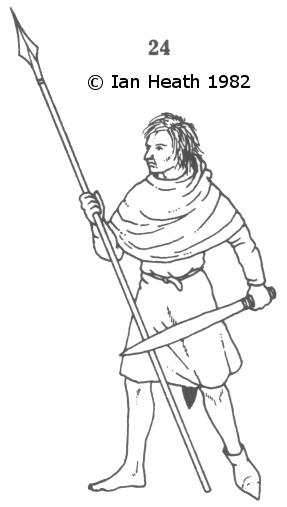|
|
WELSH FOOT-SOLDIER, 14th CENTURY
An extract from Armies of the Middle Ages, volume 1
by Ian Heath

24. WELSH FOOT-SOLDIER, 14th CENTURY
Froissart records that at Crécy Welshmen and Cornishmen (Gallois et Cornouaillois) armed with grands coutilles
advanced between the archers and men-at-arms and killed the unhorsed French knights mercilessly,
and we know from other sources that the Welsh element were chiefly men from North Wales who were armed with lances and swords,
or ‘lances and other suitable arms’.
The figure depicted here, a North Welshman from the ‘Chapter House Liber A’ of c.1295,
undoubtedly represents just such a knife-wielding soldier as Froissart describes.
One source tells us that the knife was hung from the back of the belt when not in use,
which undoubtedly contributed to the contemporary French story that the ‘English’ had tails!
Note the characteristic shape of the spearhead, still in use by the Welsh in the 15th century as witnessed by John Rous’ pictures of Glendower’s troops.
Regarding dress, an account of Welshmen in Edward I’s service in 1297 tells us that
‘in the very depth of winter they were running about barelegged.
They wore a red robe. They could not have been warm . . . I never saw them wearing armour.’
The chronicler goes on to say that their arms comprised bows, arrows, swords and javelins and that their clothes were of linen.
Barbour, describing the Welsh infantry at Bannockburn, similarly observed that they were only lightly clothed, stating that
‘where’er they gied men might them ken, for they well near all naked were, or linen clothes had but mare.’
The Welshmen serving Edward III and the Black Prince, however, were seemingly better-dressed:
Welsh contingents in uniforms are recorded as early as 1337, these uniforms being described as green and white from 1346 (see note 15).
By 1355 some Welsh infantry were even mounted.
It should be noted, incidentally, that the Welsh did not fight only for the English.
From the mid-1360s they are often to be found fighting for the French too, under such leaders as Owain Llawgoch ‘of the Red Hand’
(Owen of Wales, last representative of the royal house of Gwynedd), Ieuan Wyn and Edward ap Owain.
[Based on Littere Wallie in Chapter House Liber A]
Next: 25. SCOTTISH FOOT-SOLDIER, 14th CENTURY in Armies of the Middle Ages, Volume 1 by Ian Heath
|

